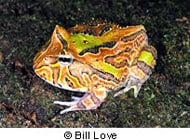Description:
The horned frogs are not an overly active species, and captives do not require particularly large terraria. An adult female (or pair) of horned frogs will thrive in a 15- to 20-gallon (horizontally oriented) aquarium. Captive specimens may be maintained either terrestrially, or in a plain terraria containing only a half inch of water. Horned frogs that are provided sufficient soil will quickly burrow and remain buried for more than 95 percent of the time, leading many owners to keep them in a plain terraria. This type of set-up requires frequent, if not daily, cleaning as bacteria proliferate in this type of terrarium. Several small food items are better for a frog than one large one. At 3 to 4 weeks old, the frog should be able to consume a pinky mouse or several crickets every 3 to 4 days. As the frog grows, the size of prey can be increased and offered less often. Adult frogs only need to be fed once every two weeks or so.
Habitat:
Grasslands, croplands and near temporary bodies of water.
Range:
Originate from the South American countries of Columbia and Argentina.
Scientific Name: Ceratophrys ornata
Species Group: frog
Family: Leptodactylidae
Size: Rarely longer than 4 to 6 inches.
Level: beginner
Weight: N/A
Dangerous: No


